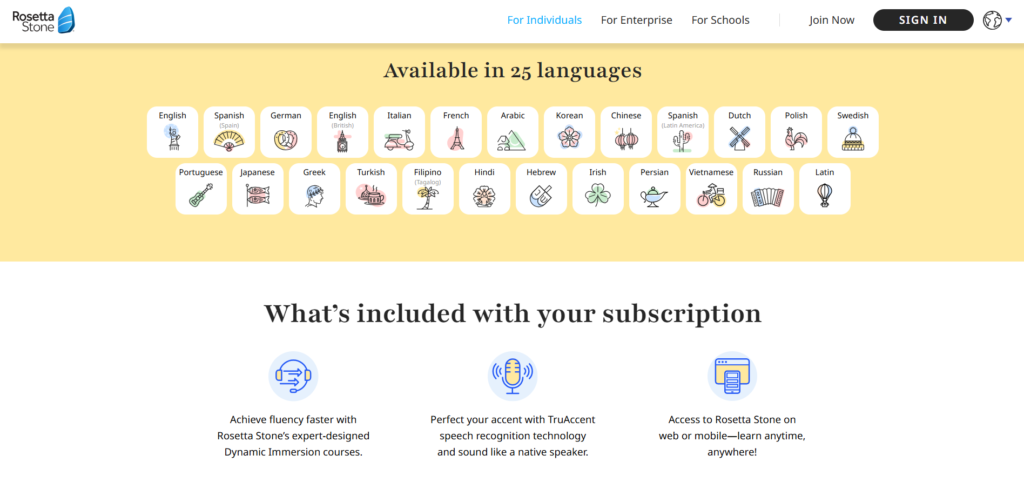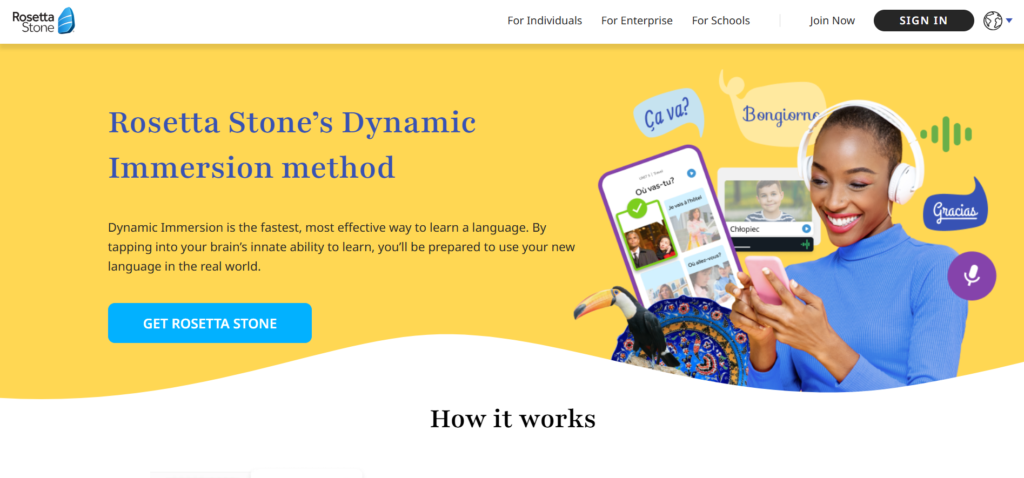Learning a new language can be an exciting and transformative experience, but it often requires time, patience, and the right tools. Among the many language-learning platforms available, Rosetta Stone has been one of the most recognized and trusted names for decades. Since its inception in 1992, Rosetta Stone has helped millions of learners across the globe. But how does it compare to other language learning tools, and is it right for you? Let’s explore in detail.
What is Rosetta Stone?

Rosetta Stone is a language learning platform that offers courses in 25 languages, helping users learn from the ground up. It uses a combination of technology and immersion techniques to teach languages in a way that mimics natural language acquisition. The company has evolved over the years, transitioning from software CDs to online platforms accessible on computers, tablets, and smartphones.
The core of Rosetta Stone’s teaching method revolves around “Dynamic Immersion,” which focuses on learning vocabulary, grammar, and sentence structures in context, without direct translations. Instead of learning words in isolation, learners understand the meaning through images, audio, and context. This technique is designed to immerse you completely in the language, encouraging you to think and respond directly in that language.
Languages Offered

Rosetta Stone offers 25 languages, making it one of the most diverse language learning platforms available. Whether you want to learn a widely spoken language like Spanish, French, or Chinese, or explore a less commonly taught language like Tagalog, Rosetta Stone has you covered.
Here is a list of the languages available:
- Spanish (Latin American and Spain)
- French
- German
- Italian
- English (American and British)
- Arabic
- Chinese (Mandarin)
- Japanese
- Korean
- Russian
- Hindi
- Portuguese (Brazilian)
- Tagalog
- Turkish
- Vietnamese
- Swedish
- Greek
- Polish
- Persian (Farsi)
- Hebrew
- Irish
- Latin
- Dutch
- Filipino
- Thai
These options make Rosetta Stone versatile, catering to a wide range of learners with different goals, whether personal, academic, or professional.
How Does Rosetta Stone Work?

Dynamic Immersion Method
Rosetta Stone’s Dynamic Immersion method is the foundation of its language learning process. This approach eliminates the use of translations and instead focuses on providing context through visual cues and spoken words. Learners are presented with images and sentences in the target language, and they are encouraged to deduce meaning without relying on their native language.
For example, you may see an image of a dog and hear the word “perro” (which means “dog” in Spanish). By seeing the image and hearing the word repeatedly, your brain begins to associate the word with the image, creating a direct connection between the two without any translation. Over time, this process builds your ability to understand the language intuitively.
This method mirrors the way children learn their first language, making it one of the most natural ways to acquire a new language. It’s a holistic approach that builds vocabulary, listening, and speaking skills all at once.
TruAccent Speech Recognition Technology
One of the standout features of Rosetta Stone is TruAccent, a proprietary speech recognition technology. This tool listens to your pronunciation as you speak and provides real-time feedback, helping you fine-tune your accent and improve your pronunciation.
This feature is particularly useful for languages with subtle pronunciation differences, such as Mandarin or Arabic. It’s also helpful for tonal languages like Vietnamese or Thai, where a small change in pronunciation can completely alter the meaning of a word. TruAccent provides valuable insights, ensuring that you can improve your speaking skills with every lesson.
Bite-Sized Lessons
Rosetta Stone’s lessons are designed to be short and digestible, making it easier for learners to fit language practice into their daily routines. Each lesson is focused on one key concept or skill, such as vocabulary building, listening comprehension, or speaking practice. This method helps you make steady progress without feeling overwhelmed.
The platform also adapts to your level of proficiency, starting with basic concepts and gradually building up to more advanced material. This ensures that learners of all levels can find appropriate lessons that challenge them without being too difficult.
Accessibility and Platforms
Rosetta Stone has made its platform accessible on multiple devices, making it convenient for learners to practice anytime, anywhere. You can use it on:
- Windows and macOS computers via the online platform or app.
- iOS and Android smartphones and tablets through the mobile app, which is great for practicing on the go.
- Xbox One for users who want to learn on their television.
This multi-device accessibility allows learners to continue their lessons regardless of where they are or what device they are using, making it easy to integrate language learning into their daily lives.
Pricing and Subscription Plans
Rosetta Stone offers several pricing plans to fit different needs and budgets. The options range from short-term plans for those who want to test the service to longer-term subscriptions for committed learners. Here are the main plans:

- 3-Month Plan: Approximately $59.85, which is around $19.95 per month.
- 12-Month Plan: Approximately $239.40, which is around $19.95 per month.
- Lifetime Plan: A one-time payment of approximately $179, which gives you access to all 25 languages for as long as you want.
Additionally, Rosetta Stone often offers discounts and promotions, so it’s worth checking their website for the latest deals. There is also a free trial available, so you can explore the platform and its features before committing to a paid plan.
Pros of Rosetta Stone
1. Immersive Learning Experience
The Dynamic Immersion method is one of the most effective ways to learn a new language, as it mimics the natural process of acquiring language skills. This immersive approach helps learners not only memorize vocabulary but also understand how the language works in context.
2. Excellent for Beginners
Rosetta Stone’s structured lessons are ideal for beginners. It starts with basic vocabulary and gradually builds up to more complex phrases and sentences, making it easy to follow for those new to the language.
3. Cross-Platform Accessibility
Rosetta Stone’s availability on multiple platforms, including computers, smartphones, and tablets, makes it convenient to practice anytime and anywhere. This flexibility is essential for learners with busy schedules.
4. TruAccent Speech Recognition
The speech recognition technology helps learners improve their pronunciation by providing real-time feedback. This feature ensures that you sound more like a native speaker over time.
5. Comprehensive Skill Coverage
Rosetta Stone helps you develop all four major language skills: speaking, listening, reading, and writing. This comprehensive approach ensures a well-rounded language education.
Cons of Rosetta Stone
1. Limited Advanced Content
While Rosetta Stone is fantastic for beginners, it’s not as useful for advanced learners. Some users feel that the platform doesn’t provide enough complex grammar lessons or advanced language skills. It is primarily geared toward foundational learning, so it may not be challenging enough for those who already have a basic grasp of the language.
2. No Focus on Grammar Rules
Rosetta Stone does not explicitly teach grammar rules in the traditional sense. The focus is on immersion and context rather than breaking down grammar concepts. While this works well for many learners, those who prefer structured grammar lessons may find it lacking.
3. Cultural Context Can Be Missing
Although Rosetta Stone is effective at teaching vocabulary and sentence structures, it doesn’t always provide the cultural context that helps deepen your understanding of a language. For example, it may not explain the different contexts in which a word or phrase might be used, which is essential for fluency.
4. Can Be Repetitive
Some learners have found that Rosetta Stone can become repetitive after a while, especially if you are working through many basic lessons. While repetition is a key part of learning a language, it can feel monotonous for those who are eager to progress more quickly.
Effectiveness and User Feedback
Many users report positive experiences with Rosetta Stone, especially in the early stages of language learning. The platform’s focus on immersion and real-time pronunciation feedback helps learners retain vocabulary and improve their speaking skills.
However, some learners feel the need for additional resources to fully understand the grammar and cultural nuances of the language. For those who want to progress beyond basic fluency, combining Rosetta Stone with other materials such as grammar books or language exchange can be beneficial.
Final Thoughts
Rosetta Stone is an excellent tool for beginners and intermediate learners who want to build a solid foundation in a new language. Its immersive approach, speech recognition technology, and wide range of available languages make it an appealing choice for many language learners. However, advanced learners may find it lacking in depth, particularly when it comes to grammar explanations and cultural context.
Overall, Rosetta Stone is a great option for those looking for an engaging, flexible, and effective language learning tool, particularly if you’re just starting your language learning journey.
FAQ’s
an Rosetta Stone help with pronunciation?
Yes, it includes speech recognition technology to assist with pronunciation practice.
Does Rosetta Stone include grammar lessons?
Grammar is taught implicitly, not explicitly, through immersion.
What age group is Rosetta Stone suitable for?
Rosetta Stone is suitable for learners of all ages, including children and adults.
Is Rosetta Stone a good choice for travelers?
Yes, it’s ideal for learning basic phrases and vocabulary for travel.
Can I use Rosetta Stone on multiple devices?
Yes, you can use your account on multiple devices like computers, tablets, and smartphones.
Does Rosetta Stone offer live tutoring sessions?
Live tutoring sessions are available with the “Rosetta Stone Live” feature for an additional cost.
How long does it take to complete a course on Rosetta Stone?
Completion time varies depending on your dedication, but it can take several months to finish one level.
